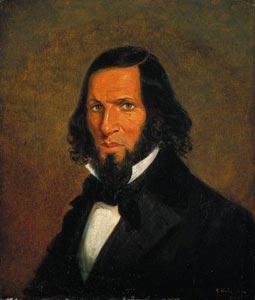|
Biography of Cornelius KRIEGHOFF
|
|

Cornelius Krieghoff, self-portrait
BIOGRAPHY
Born in Amsterdam in 1815 Cornelius Krieghoff is thought to have immigrated to the United States in 1835 or 1836. Sometime after his arrival in New York he met a young woman from Quebec who became his life-long companion. He enlisted in the American army in 1837 with the intention of recording the war being fought against the Seminole Indians. Demobilized in 1840, he joined his family in Montreal. From 1841 to 1846 they lived in Rochester, New York, although Krieghoff studied in Paris for a short time during this period and he also spent some time in Toronto promoting his work. He settled in Montreal in 1846.
Krieghoff quickly established himself as an artist in Montreal, thriving until the early 1850s when the poor economy affected the art market. It is said that to survive he had to paint sign-boards and furniture as well as giving poorly paid painting lessons. He also tried to sell his paintings door to door. Fate was with him when John Budden, a Quebec City businessman, saw his paintings and was drawn to their picturesque subjects. He encouraged him to move to Quebec City, introducing him to the artistic community and the social life of the city. Krieghoff attained his greatest artistic and financial success during his years in Quebec City.
The Krieghoffs left Quebec City in 1863 or 1864 for Europe, returning in 1867. They left Canada for the last time in late 1871, moving to Chicago where their daughter lived. He died in March 1872 at the age of 57.
SUBJECT MATTER
Krieghoff portrayed in his paintings the reality of the Quebec of his time; the rustic country life and the primitive and rugged living conditions, which touched him in particular.
In this nineteenth-century milieu, there was in Quebec as well as in English Canada and the United States an insatiable curiosity about rustic life, folklore and North American Indians.
The two common themes found in the visual arts of the period are portraits and landscapes. Cornelius Krieghoff shrewdly developed a new genre, which was a combination of these two fashionable themes, portraying the day-to-day life surrounding him. Paintings of trappers on snowshoes, ice bridges, habitant shanties, scenes of portaging and hunting, horse races, snow storms, maple sugar camps, toboggan slides, autumn forest scenes and Indian camps succeeded one another in profusion. The paintings contain an element of humour and at times are little more than caricatures. Krieghoff produced over 1200 paintings which captured the spirit of Quebec as well as paintings on Dutch and German genre subjects.
TECHNIQUE/MEDIUM
Krieghoff worked almost exclusively in oils on canvas.
BIBLIOGRAPHY
-
J. R. Harper, Krieghoff, 1979
-
M. Bigué et G. Robert, La peinture au Québec depuis ses origines, 1978
-
J. Russel et Harper, Cornelius Krieghoff: the Habitant Farm, Ottawa, 1977
-
Attitude esthétique de Cornélius Krieghoff, Racar, Saskatoon, 1974
-
Scenes in Canada, C. Krieghoff, 1848-1862, Montréal, 1972
-
Cornelius Krieghoff: Peintre de moeurs, Ottawa, 1972
-
H. de Jouvancourt, Cornelius Krieghoff, Montréal, 1971
-
G. Morrisset, La peinture traditionnelle au Canada Français, Ottawa, 1960
-
The Fine Arts in Canada, Mac Tavish et Newton, Toronto, 1925
|
 |
|